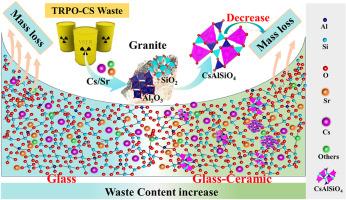天然矿物材料协同固定化复合TRPO-CS核废料:玻璃和CsAlSiO4为主的玻璃陶瓷
IF 5.6
2区 材料科学
Q1 MATERIALS SCIENCE, CERAMICS
引用次数: 0
摘要
本研究提出了一种受自然启发的方法,利用天然角闪石麻粒岩创新地固定化复杂的TRPO-CS废物(含Cs, Sr和Ba),利用其独特的双相形成能力进行可持续的核废料处理。通过对质量损失行为、相演化、微观结构、元素分布和玻璃-陶瓷相变的综合表征,证明花岗岩可以实现复合TRPO-CS废弃物的双相稳定凝固:玻璃(0-20 wt%)和CsAlSiO4主导的玻璃-陶瓷(30-60 wt%)。CsAlSiO4陶瓷相的形成显著增强了Cs和Sr的固定化,同时减少了质量损失(Cs和Sr的最小值分别为~ 6%和~ 0.3%)。凝固表现出优异的机械稳定性(密度:3.20 g/cm3;维氏硬度:8.58 GPa)和化学耐久性(28 d后Cs、Sr和Ba的浸出率:~ 10−4 g/m2·d)。本研究首次建立了天然花岗岩作为固定复杂挥发性TRPO-CS废物的高稳定基质,为具有挑战性的低熔点放射性废物流提供了可靠的解决方案。本文章由计算机程序翻译,如有差异,请以英文原文为准。

Synergistic immobilization of complex TRPO-CS nuclear waste by natural mineral materials: Glass and CsAlSiO4 dominant glass-ceramics
This study presents a nature-inspired approach for innovatively immobilizing complex TRPO-CS waste (containing Cs, Sr, and Ba) using natural hornblende granulite, leveraging its unique dual-phase formation capability for sustainable nuclear waste disposal. Through comprehensive characterization of mass loss behavior, phase evolution, microstructure, elemental distribution, and glass-ceramic transformation, demonstrated that granite can achieve dual phase stable solidification of complex TRPO-CS waste: glass (0-20 wt%) and CsAlSiO4 dominant glass-ceramics (30-60 wt%). The formation of the CsAlSiO4 ceramic phase significantly enhances the immobilization of Cs and Sr while reducing mass loss (with minimum values of ∼6 % for Cs and ∼0.3 % for Sr, respectively). The solidification demonstrates exceptional mechanical stability (density: 3.20 g/cm3; Vickers hardness: 8.58 GPa) and chemical durability (leaching rates: ∼10−4 g/m2·d for Cs, Sr and Ba after 28 d). This study establishes natural granite as a highly stable matrix for immobilizing complex volatile TRPO-CS waste for the first time, providing a reliable solution for challenging low melting point radioactive waste streams.
求助全文
通过发布文献求助,成功后即可免费获取论文全文。
去求助
来源期刊

Ceramics International
工程技术-材料科学:硅酸盐
CiteScore
9.40
自引率
15.40%
发文量
4558
审稿时长
25 days
期刊介绍:
Ceramics International covers the science of advanced ceramic materials. The journal encourages contributions that demonstrate how an understanding of the basic chemical and physical phenomena may direct materials design and stimulate ideas for new or improved processing techniques, in order to obtain materials with desired structural features and properties.
Ceramics International covers oxide and non-oxide ceramics, functional glasses, glass ceramics, amorphous inorganic non-metallic materials (and their combinations with metal and organic materials), in the form of particulates, dense or porous bodies, thin/thick films and laminated, graded and composite structures. Process related topics such as ceramic-ceramic joints or joining ceramics with dissimilar materials, as well as surface finishing and conditioning are also covered. Besides traditional processing techniques, manufacturing routes of interest include innovative procedures benefiting from externally applied stresses, electromagnetic fields and energetic beams, as well as top-down and self-assembly nanotechnology approaches. In addition, the journal welcomes submissions on bio-inspired and bio-enabled materials designs, experimentally validated multi scale modelling and simulation for materials design, and the use of the most advanced chemical and physical characterization techniques of structure, properties and behaviour.
Technologically relevant low-dimensional systems are a particular focus of Ceramics International. These include 0, 1 and 2-D nanomaterials (also covering CNTs, graphene and related materials, and diamond-like carbons), their nanocomposites, as well as nano-hybrids and hierarchical multifunctional nanostructures that might integrate molecular, biological and electronic components.
 求助内容:
求助内容: 应助结果提醒方式:
应助结果提醒方式:


